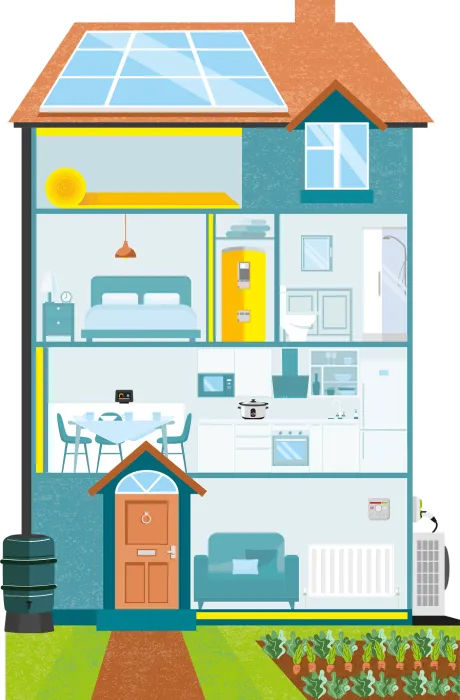
Need a little help? There could be a grant for your home
The government runs several schemes to help people upgrade the heating and insulation of their homes. The aim is to help them save money and cut their carbon footprint.
You can view a summary of grants on the Hart District Council website.
But first have a play with our interactive diagram on this page.
It’ll get you thinking about how to make your home more energy-efficient. And it’ll give you tips about where to get started and what grants might be available.
Just click on a number on the diagram to bring up advice and useful links for that part of the house. You can also read an accessible version of the information in the interactive house diagram.
3 questions to ask before deciding which grant might be right for you
-
do I want to upgrade my heating system? − Boiler Upgrade Scheme
-
am I on a low income or claiming certain benefits? − Energy Company Obligation scheme
-
am I on a higher income? − Great British Insulation scheme

These are a great way to tap free renewable energy from the Sun. We know about four schemes that might help with the costs, depending on your circumstances:
- Energy Company Obligation 4
- Green Deal
- Home Upgrade Scheme
- Solar Together group-buying scheme
Read about grants on the Hart District Council website, read our case study about Hart residents with solar panels or follow the link below to read about Solar Together.
It’s easy to forget about your home’s roof space, but it’s really important to insulate it properly. You can lose a ton of heat from an uninsulated loft. We know about three schemes that might help with the costs of loft insulation, depending on your circumstances:
- Great British Insulation Scheme
- Energy Company Obligation 4
- Home Upgrade Scheme
Read about grants on the Hart District Council website, or follow the link below for advice from the Energy Saving Trust.
New windows and doors can make a massive difference to the amount of heat your home retains. We know about three schemes that might help with the costs, depending on your circumstances:
- Great British Insulation Scheme
- Energy Company Obligation 4
- Home Upgrade Scheme
You can lose a lot of heat from poor-quality windows and doors. Thermal images are a great way to check if this is happening, because they show exactly where heat is escaping. Hart District Council has set up a scheme, in partnership with town and parish councils in Hart, to give residents access to thermal images of their homes.
Read about grants on the Hart District Council website, or follow the link below for advice about windows and doors.
It’s a great idea to switch to LED lights in your home. They’re energy-efficient, cost-effective, long-lasting and environmentally friendly. While an old-school incandescent light would last about 1,000 hours of continuous use, LED lights are designed to last for between 25,000 and 50,000 hours. They convert 95% of the total energy they use to light and the other 5% to heat. That’s amazing compared with fluorescent lights. They convert just 5% to light and 95% to heat.
Lighting is relatively cheap, so it’s unlikely you’ll get a grant just for that. Follow the link below for advice from the Energy Saving Trust.
You can save money and cut heat loss from your water tank by up to 75% just by giving it a cosy jacket. Going from a completely uninsulated tank to a well-insulated one can save you around £150 a year or more.
Jackets are widely available at hardware and DIY stores and come ready made to fit standard sizes. It’s an environmentally friendly option saving around 160kg per year in carbon dioxide emissions. Jackets are pretty cheap, so it’s unlikely you’ll get a grant to buy one, but the cost might be covered in a grant for general insulation.
You’ll save money and help the environment by using less water in your home. A lot of homes are now on metered water, so the more you use the more you’ll pay. By using less you’ll also help protect the environment. It means the water companies need to use less energy and chemicals to treat and deliver water. This in turn reduces pollution and conserves fuel resources. Top tips for saving water in your home include:
- take showers not baths
- fit a water-saving device to your shower head
- limit your shower time to 3 or 4 minutes a day
- save up your dirty laundry to do a full load every time you wash
Follow the link below for more advice from water regulator Ofwat.
It’s a great idea to insulate the walls in your home, because 35% to 40% of heat loss in an uninsulated home is through the walls. There are basically two types of insulation for walls:
- cavity-wall insulation
- solid-wall insulation
You’ll need to check if your home is suitable for cavity wall insulation. If it’s a house built after 1920, it will probably have a fillable cavity. The cavity is likely to be 50mm (2 inches) wide. Prior to 1930 it may be only 25mm wide, which makes installation of cavity wall insulation more tricky, more expensive and less effective.
Solid walls can be insulated, either from the inside or the outside. This will cost more than insulating a standard cavity wall, but the savings on your heating bills will be bigger too.
Follow the link below for more advice from the Energy Saving Trust
These ingenious devices are a great way to keep track of your energy costs in real time. They can help you save money because they put you in control. You’ll get a clear picture of how and when you’re using energy in your home. Over 80% of people with smart meters say they have a better idea of their energy costs. The government reckons that total annual savings from smart meters will be more than £1.2 billion a year in the UK by 2030.
Follow the link below for more advice from the Energy Saving Trust.
You’ll save money and help the environment by switching to energy-efficient appliances as much as possible. When you’re replacing your old electrical appliances, look out for the energy-efficiency rating scale. This should be clearly displayed on the product.
In the UK, appliances are rated for energy efficiency on a scale from A to G, with A being the most efficient. Some appliances use an older scale, from A+++ to G, with A+++ being the most efficient.
Depending on what you’re cooking, some appliances are more energy efficient than others. The Energy Saving Trust has advice: Is it cheaper to cook with an air fryer, oven, microwave, hob or slow cooker?
Draught-proofing is one of the most cost-effective ways to save energy and money in your home. That’s because gaps in doors and windows let heat out and cold air in. You need some ventilation to keep fresh air circulating, but it should be controlled by you through vents and windows.
There are loads of inexpensive and easy ways to add draught proofing. Here are some examples for your front door to give you an idea of what to look out for:
- keyhole. Buy a purpose-made cover that drops a metal disc over the keyhole
- letterbox. Use a letterbox flap or brush, but remember to measure your letterbox before you buy
- gap at the bottom. Use a brush or hinged flap draught excluder
- gaps around the edges. Fit foam, brush or wiper strips like those used for windows
Follow the link below for advice from the Energy Saving Trust.
Most modern heating systems are controlled by wall-mounted thermostats. They’re very sensitive and let you control the temperature in your home quite precisely. If you already have one, make sure it’s working properly – if not, get it replaced. You should also consider fitting a thermostatic radiator valve to every radiator.
This will give you even greater control over the temperature in individual rooms. You’ll save money if you only heat the rooms you use regularly; turn down the control on radiators in rooms you’re not using. Installing thermostatic radiator valves in every room can reduce your energy consumption by up to 40%.
Follow the link below for advice from the Energy Saving Trust.
This might not seem a big deal, but it’s amazing what a difference it makes. Someone looking after a well-stocked garden measuring 10m by 10m could use 2,000 litres of water a week in dry weather. That’s enough to fill 24 average-sized baths! A garden sprinkler can use as much as 1,000 litres of water per hour.
So, using stored rainwater on your garden instead of water from the tap could save thousands of litres a year. That’s water you won’t have to pay for on the meter, and which your water company won’t have to process using energy and chemicals.
Follow the link below for advice from the Royal Horticultural Society.
These are a great way to save energy and cut your carbon footprint. Read our case study on heat pumps on this site, and follow the link below to read advice from the Energy Saving Trust.
An electric vehicle can help you cut your carbon tyre print and slash running costs. Two Hart residents who spoke to Impact Hart said it cost them about £5 to drive 200 miles in their electric car, compared to £50 for the same distance in a diesel car.
If you already have a petrol or diesel car, remember that a third of a vehicle's lifetime carbon emissions are generated during manufacture. So, even if you’re itching to upgrade, it’s often better for the environment to keep your fossil-fuel car on the road as long as possible before going electric.
Follow the link below for advice from the Energy Saving Trust.
On average, about 10% of heat loss in a home occurs through floors. So it often makes sense to insulate them, particularly at ground level or in a basement. Rooms above an unheated space such as a garage can also benefit from floor insulation.
There are lots of options. For example, you can lay rigid insulation on top of a concrete floor. If you have wooden floors, you can usually add insulation such as mineral wool underneath them.
Follow the link below for advice from the Energy Saving Trust.
If you’re lucky enough to have a garden, it can be a source of pleasure all year round. It can also help you live more sustainably and do your bit to prevent climate change. If you grow fruit and veg in your garden, you’ll know it’s a cheap and easy way to get healthy food for your household. It also cuts your carbon footprint by reducing the times you have to go to the shops. And it cuts the carbon footprint of the food industry overall, because homegrown fruit and veg doesn’t travel miles by lorry.
Gardens are also a great place to encourage biodiversity. A garden with lots of plants and micro-habitats provides food and shelter for wildlife – from bees and butterflies to hedgehogs and birds. There's loads of advice out there, like this blog from the RSPB on how to make your garden bird-friendly.
The garden in our illustration looks neat and tidy but yours can be a haven for wildlife if you let it run just a bit wild.
Follow the link below to read about a great way to help plants and animals in your garden.

